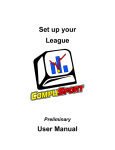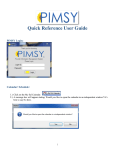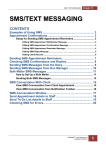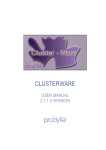Download clicking here. - SAM University
Transcript
SALES ACTIVITY MANAGEMENT, INC. P R O M I S E Seven Top Reasons to be in the Financial Services Industry Population The U.S. population is living longer and growing at the rate of 2.5 million per year. Retention The industry values retention and provides supportive tools and systems. Opportunity The opportunity to accumulate wealth and help others is abundant. Getting Started with eScoreBoard™ Financial Services Producer Version Mentoring Our industry is built on mentoring and helping each other succeed. Insurance The “I” word is back in vogue and more important than ever. Stability Financial services products are needed during all economic times. Entrepreneurship The entrepreneurial spirit and freedom to be your own boss is alive and well. Sales Activity Management, Inc. • 1100 Jorie Boulevard, Suite 314 Oak Brook, IL 60523 • 1-800-254-4726 www.SalesActivityManagement.com • www.eScoreBoard.com Work Smart™ eScoreBoard™ Getting Started Guide Table of Contents Introduction to eScoreBoard......................................................... 1-2 Three Principles of Sales Activity Management.............................. 3 Getting Started............................................................................... 4-11 Producer Activity........................................................................ 4 Step 1 - Log onto eScoreBoard................................................. 5-6 Step 2 - Administration.............................................................. 7 Step 3 - Goals............................................................................ 8 Step 4 - Input Activity Data........................................................ 9 Step 5 - Your Business Assessment: Reports.......................... 10 Helpful Hints. ................................................................................. 13 Final Comments................................................................................ 13 For technical assistance, send email to [email protected] or call 1-800-596-4726 ©2010 by Sales Activity Management, Inc. Category and Ratio Definitions........................................................ 11-12 eScoreBoard™ Getting Started Guide Introduction to eScoreBoard Welcome to eScoreBoard! Its purpose is to allow you to achieve your potential, while making you more efficient and effective through the use of technology. Though results are your primary motivation, it is the “high pay-off activities" that will help you get there. This “Getting Started Guide” is designed to be your do-it-yourself guide to prepare you to effectively use eScoreBoard by getting you started with both the concept of Activity Management (through readings on the philosophy) and with the tools (through an activity checklist). It is not intended to be a complete User Reference Manual. The eScoreBoard User Manual and Help Guide are available once you have logged on and can be found by clicking the “Help” tab from any screen. We believe… It starts with You You need to care enough about your business to input the data, so the reports generated by eScoreBoard have value to you as a business owner. Unless you do what you need to do on a daily and weekly basis you, and your productivity, will drift. Your Manager is Invaluable No one is more influential on your career than a trusted manager (or mentor). Your relationship is one of the most critical, providing you with an objective view of your practice and connecting you to your firm to take advantage of the value it brings. What is sales activity management? It is a philosophy and a strategy that empowers its users to have more confidence and better control of their own success by providing a performance road map to get on track and stay on track. It is the belief that we all have the potential to achieve great things and that activity management doesn’t leave success to chance. Here is a more complete definition: Sales Activity Management: the self-empowering process of identifying, managing and measuring high-payoff sales activities in order to continually improve results. By using the principles of activity management you will achieve a better understanding of your business. You will be able to see both the activities that are driving your results, as well as identify where bottlenecks are occurring. Your manager or mentor can play a crucial role in clearing any bottlenecks by helping you to diagnose them and develop solutions. What is eScoreBoard? eScoreBoard is an integral part of a collection of tools that come together to form a turnkey activity management system for your practice. From a technical standpoint, eScoreBoard is an online scorekeeping system which enables you to enter your personal productivity goals so you can submit activity data, and produce reports to analyze your progress towards your goals. Submitted activity can be viewed and analyzed by both you and your manager, so eScoreBoard is a perfect tool for personal accountability, as well as for your one-onone coaching sessions. Page 1 For technical assistance, send email to [email protected] or call 1-800-596-4726 eScoreBoard™ Getting Started Guide When you are using eScoreBoard you’ll experience the benefits of a secure, online-hosted application that provides: • • • • 24/7 availability Instant access to reports that update in real-time Available anywhere you have internet access (work, home or while you’re on the road) The ability to submit daily/weekly activity via an email link to eScoreBoard eScoreBoard quickly converts the data entered into easy-to-use summary reports that include skill ratios, dollar value per activity, charts/graphs, etc. eScoreBoard is not a Client Relationship Management (CRM) system. We let others manage information; we help you manage activity and success. You should still use whatever automated contact management system you are currently using along with your Planner. eScoreBoard requires only that activity data be collected and entered on a daily or weekly basis…eScoreBoard handles the rest. What are some foreseeable obstacles? • If you are like most people, you don’t like change. Your desire for change has to have enough significant, perceived benefit in order to justify the change • Only 1 in 4 people gravitate toward systems. Turn that around and you realize that 3 out of 4 of us have to be led to them • You want independence. You were attracted to the financial services industry because of its promise of independence; however, most of us tend to mistake independence with no need for discipline and regimen • People tend to resist accountability Despite how proven and pragmatic it is you may find reasons to resist positive change. Don’t be discouraged, you will need to let repetition do its job and you’ll eventually recognize that you and your practice are the main beneficiaries. We trust you will soon be a believer through your own experience and results. How long will it take to see results? First things first, research suggests its takes 21-days to form a new habit, and it is no different with reporting activity. Accounting for weekends, it will take you 30 calendar days to establish this new habit. To say that the first month is important is an understatement. You need to stay focused and organized. Once the habits are formed (for reporting sales activity) it will take another 30-60 days to feel like it is a regular part of your practice management process. At the end of the first 90 days (or sometimes sooner) you will be able to see the trends of your practice begin to emerge. Anything from gathering recommendations – to phoning effectiveness – to your average commission per case, you’ll have the information you need at your fingertips to be able to hone in on what you are doing well (so you don’t forget to keep doing it) and where you need to improve. Ultimately, you will improve your efficiency and make more money. Our belief is that while you cannot control results you can control the activities that help lead you there. An activity-based practice management system does not leave success to chance. It stimulates regimen, discipline and repetition which can go a long way to increase confidence and productivity. It brings out our best. Page 2 For technical assistance, send email to [email protected] or call 1-800-596-4726 eScoreBoard™ Getting Started Guide Three Principles of Sales Activity Management These are the three guiding principles of Sales Activity Management: • • • Sales is a numbers game (Quantity) Quality activities produce quality results (Quality) What gets measured tends to get done – and improve (Measurement) By measuring the quality and quantity of sales activities you’ll gain a solid understanding of your practice and where your strengths and opportunities for improvement lie. Activity management is a career long commitment. You should avoid the mistake of thinking that activity-tracking is only necessary during the early years of your career. Discipline is a career-long commitment that can pay big dividends. Although activity management will certainly improve your performance when implemented correctly, it is not a panacea. We can’t forget that the financial services business is first and foremost a people business. Remember that you are behind the numbers and at the end of the day, those who establish the best relationships and see the most people, will succeed. Finally, you must accept the fact that you are ultimately responsible for your own success. It has been said that destiny is not a matter of chance, but one of choice. It is the activities that you choose to perform that will ultimately shape your destiny, and you are the one who is responsible and in control of those activities. We wish you the greatest of success, and trust that eScoreBoard will help you achieve it. We have included the following recommended readings to help you get started. The Spirit to Serve, by J.W. Marriott E-Myth, by Michael Gerber As a Man Thinketh, by James Allen Think & Grow Rich, by Napoleon Hill The Common Denominator of Success, by Albert E.N. Gray Page 3 For technical assistance, send email to [email protected] or call 1-800-596-4726 eScoreBoard™ Getting Started Guide Producer Activity Purpose: As a result of completing this activity, you will become familiar with the basic functionality of eScoreBoard and be able to perform these Basic eScoreBoard skills (more details and screenshots may be found in the following pages): • Login to the system • Administration – change password, enable email reminder & add Administrator (as applicable) • Goals – Review or Set Goals and Time Away (as applicable) • Activity – Input Activity data • Reports – Set up a Weekly Standard Report Instructions: • The Producer's Activity Checklist below details a suggested process for learning to use eScoreBoard • Use the Producer's Activity Checklist to track your progress as you complete each task This Activity Checklist should be completed as soon as you are notified about having access to the eScoreBoard. Producer's Activity Checklist Status Task/Outcome Where To Find It Read: • eScoreBoard Introduction • Three Principles of SAM • Getting Started • What’s in it for me? brochure Check status box and continue to the next task. eScoreBoard Getting Started Guide Step 1 - Access Login to eScoreBoard Check status box and continue to the next task. eScoreBoard Getting Started Guide Step 2 - Administration Change your password from the system default Verify that your Email Reminder is “enabled” Add an “Administrator” if applicable Check status box and continue to the next task. eScoreBoard Getting Started Guide What’s in it for me? brochure Quick Reference Card www.escoreboard.com Quick Reference Card www.escoreboard.com Step 3 - Goals eScoreBoard Getting Started Guide Review or Set Goals and Time Away (as applicable) Quick Reference Card Check status box and continue to the next task. www.escoreboard.com Step 4 - Activity Input Activity Data Check status box and continue to the next task. eScoreBoard Getting Started Guide Step 5 - Reports Set up a Weekly Standard Report Check status box. eScoreBoard Getting Started Guide Quick Reference Card www.escoreboard.com Quick Reference Card www.escoreboard.com Page 4 For technical assistance, send email to [email protected] or call 1-800-596-4726 eScoreBoard™ Getting Started Guide Step 1 - Login to eScoreBoard From Internet Explorer, go to www.escoreboard.com, and login with the UserID and password provided by your manager or administrator. Enter your User ID and password in the “eScoreBoard Login” box shown on your screen. Click the “Log In “ button. Clicking the “Auto login” checkbox will allow you to access the system with only your password. For easy access to eScoreBoard, be sure to set it up an internet “Favorite” or as a “shortcut icon” on your desktop. Refer to the Training Resources “User Documents” for more information. Figure 1: eScoreBoard login screen Basic Navigation: Familiarize yourself with the tabs across the top. The color-coded tabs are the same for all users regardless of access level. The online Help is contact sensitive so it displays help topics for the page you are viewing. Your “Dashboard” (home page) includes the following features: • • My Focus - Helps you to focus on sales activities that drive your practice. The Performance Funnel is your prospecting activities “pipeline” and shows your sales activities conversion ratio. The Success Gauges highlight four key success metrics to your goals. My Projections - Gives you a snapshot of your year-to-date performance as well as how your full year will look if you maintain the current pace. It also shows how your full year will look if you begin to hit your established goals so you can compare possible future sales performance based on historical sales and goals. Page 5 For technical assistance, send email to [email protected] or call 1-800-596-4726 eScoreBoard™ Getting Started Guide • • • • • • • • SAM Action Plan - Notes may be created from the “SAM Action Plan” sub-tab in the Reports Section. The notes posted to your Dashboard are a result of the Coaching 1:1 Meeting with your Manager and the Action Plan that was developed. Am I Reaching My Goal - Goal Meters measure performance for the Month, Quarter and Year-to-Date to your Goals for those time frames. My Trends - Compare specific Activities and Results from the drop down menu to current and prior week, month and quarter time frames. Top Performers YTD - Shows the top Producers in your Agency for peer comparison. What-If Calculator - Shows the potential impact of current key metrics; Closing Interviews, Closing % and Average Size Case, to “what if” numbers for increasing Weekly and Annual production. Current numbers based on the average last 13 weeks producer results. My Reporting History - Using the color coded calendar, you can easily see which weeks you HAVE reported your activity numbers in “Green” and any weeks you HAVE NOT reported in “Red” My Favorite Reports - One-click access to your most frequently viewed reports. If you value a report enough to automate it by email, then it should be added to your Favorites on your dashboard. See Reports, Step 6. Training Resources - Easy access to the eScoreBoard User Documents Figure 2: Dashboard Page 6 For technical assistance, send email to [email protected] or call 1-800-596-4726 eScoreBoard™ Getting Started Guide Step 2 - Administration Change Password and Verify Account Settings The first time you login, you will use a default password, such as “changeme” or “password” (your manager or administrator will let you know which). Follow these steps to change your password: 1. Click on the red Administration tab and you will be in the “My Profile” sub-tab 2. Click on the “Change Password” button on the lower right of the screen. You will be prompted to enter your current password and your new password twice for verification 3. Click the “Save Password” button. You will receive verification that your password has been changed. Click the “X” to close out the password box and return to the main screen. 4. In Account Settings, verify that the Weekly or Daily radio button is checked as appropriate. Verify that the Email Reminder radio button is checked “Enabled” Add Administrator (as applicable) The “My Administrators” sub-tab allows you to create an account for an administrator who doesn’t report activity but may access your account for administrative functions; to report your activity, set up your reports, etc. The Administrator will have a separate User ID and Password to access your account. Follow these steps to create an administrator account: 1. Under the red “Administration” tab, click on the “My Administrators” sub-tab. Click “New” in the lower right of the screen 2. Admin Details – Fill in each field with the appropriate information. In each of the password input fields, input the initial password for this administrator. We suggest “changeme” as the initial password that may be changed when the eScoreBoard is accessed for the first time by the Administrator. 3. Available Users – Select your name from the available list on the left and “Add” to the Selected Users section. 4. Welcome Email – Click the Welcome Email checkbox to send the newly added Administrator an automated email containing the eScoreBoard internet address, the User ID and Password to access the system. This option is only available when you add the new Administrator to the system. 5. Click the “Save” button to add the Administrator to the system. 6. Set Admin Permissions – Click on your name as the Selected User. In the Set Admin Permissions box, set the administrative permissions for each function by verifying the default option or clicking on “No Access” from the “Edit” option. 7. Save Permissions – Click the Save Permissions button. Figure 3: “Administration” tab, My Profile Screen Page 7 For technical assistance, send email to [email protected] or call 1-800-596-4726 eScoreBoard™ Getting Started Guide Step 3 - Goals One of the most critical steps in using eScoreBoard is establishing your activity and production goals. Goals are what bring activity management into focus by allowing you to measure your activity weekly (or daily) against the standards you set with your manager. Remember, an effective goal-setting process actually begins with working with your manager to create a well-defined business and marketing plan. Follow these steps to set goals: Click on the green Goals tab and you will be in the Overview sub-tab. To the right of the Overview sub-tab are the Set Time Away and Set Goals sub-tabs. Overview • Just beneath your name, the “Annual Commission Goal” shows your annual production goal based on the total commission dollars input weekly times the number of working weeks excluding weeks set as “time away” • The Activity and Results sections show the standards for your activities and production on a weekly basis • The scrolling calendar on the left-hand side of the screen shows the weeks of the year that you have goals set in green and those weeks without goals in red. It also highlights any set time away in yellow Set Time Away 1. Click on the Set Time Away sub-tab 2. Use the drop down menu or the annual calendar to the left to select a specific week. 3. Click the radio button “TIME AWAY…I will be out of the office the entire week” 4. Click the “Submit” button to the right. You will receive confirmation that your “working status changed successfully.” 5. The selected week is now highlighted on your calendar Set Goals 1. Click on the Set Goals sub-tab 2. Choose a source for your goals by clicking on the appropriate radio button. 3. Based on your choice in Step 1, either select a goal profile, your criteria or manually enter your weekly goals 4. Select a timeframe to recalculate your goals 5. Review your Goal Summary – annual commission goal for your number of working weeks 6. Click the “Submit” button Figure 4: Goals “Overview” sub-tab screen Helpful Hint: If the activity and commission goals are zero, see your manager so they can enter your goals into eScoreBoard. Be sure to discuss your strategy for reaching your established goals with your manager. Page 8 For technical assistance, send email to [email protected] or call 1-800-596-4726 eScoreBoard™ Getting Started Guide Step 4 - Input Activity Data Activity may be input by either of two ways: clicking the hyperlink from the automated email reminder that you receive daily/weekly OR from the Activity Tab on your eScoreBoard Dashboard. Follow these steps to input activity data: 1. Click on the orange Activity Tab to input activity data. 2. Verify or select a time frame (week # or day) you would like to input activities for 3. Enter your activity from your planner in each category (default input shows “0” ) 4. Enter any notes regarding the activity you just entered: Case information, business and personal reminders and 1:1 session reminders to review with your manager 5. If applicable, select the “TIME AWAY” radio button; otherwise, leave the default selection. 6. Click Submit Automated Email Reminder – Click on the hyperlink which links you directly into your Activity Input Screen. Follow Steps 2 through 6 shown above. Figure 5: Activity tab screen Helpful Hint: eScoreBoard automatically sends you a weekly (or daily) email that provides a link directly to eScoreBoard to enter your activity data. Page 9 For technical assistance, send email to [email protected] or call 1-800-596-4726 eScoreBoard™ Getting Started Guide Step 5 - Your Business Assessment: Reports The Reports Tab from the eScoreBoard Dashboard may be used to set up, view and schedule a standard activity report. These timely reports are vital for your consistent business assessment, focusing on high-payoff activities, and improving your results. Although there are many types of reports available from the Reports tab, the standard report will be discussed for our example and is the one that you will wish to view and schedule on at least a weekly basis. The standard report will display the following for your analysis: • Total activities and production for the time frame that you are selecting (daily, weekly, monthly, quarterly, etc.) • Activities to your goals in color coded goal percentages (Note: get the red out!) • DVA - Dollar Value of Activities. As you grow your business, these dollar values will become a key business metric for improvement and success • Skill Ratios & Vital Signs – Key success ratios and percentages representing the “quality” of the sales activities and performance Follow these steps to view, print and schedule your reports: 1. Click on the blue Reports tab. You will be in the “Basic” sub-tab. Select the “Standard” report type. 2. Select the time frame and the options you would like displayed in the report 3. Click on the “View Report” button to generate the report 4. Schedule any reports to come to you by email on an automated basis for any time frame: weekly, monthly, quarterly or other time frame. Be sure to also set up these reports on your Dashboard as your “Favorites” so that you may “drill down” to time frames as desired. See “Schedule This Report” and “Add to Favorites” links on the Reports Basic tab 5. To print or save a Report, click on “View Report” to bring up the report. Click the print icon or select a format for printing/saving and click the Export link. Once in the Export function, you can “Open” the report and print or “Save” the report. Note: you can also adjust the size of the document from the “100%” drop down menu Figure 6: Reports tab screen Check out the new and enhanced eScoreBoard Reports: Performance Bundled Reports, Usage Report, The SAM Action Plan, Graphs and more. The SAM Action Plan is an electronic preparation and follow-up tool for the coaching 1:1 session that allows for you and your Manager’s input, emailing/printing and file documentation. Notes from the Action Plan will be posted on your Dashboard and displayed “front and center” for you all week. Page 10 For technical assistance, send email to [email protected] or call 1-800-596-4726 eScoreBoard™ Getting Started Guide Category and Ratio Definitions Category Definitions Days Worked - The number of days you worked. Fractional days (i.e. 0.5) are accepted. Dials - Dials for business appointments. If you dial it, count it. Reached - Actual phone contacts with people who have the authority to book an appointment with you. Appts Set - The number of appointments booked for any future date as a result of the telephone reaches. Appts Made - The total number of appointments appearing on your calendar as you begin each day/week, including those made by phone or in person. Appts Kept - The total number of appointments that are kept each day/week. Referral Attempts - The total number of actual times you engaged in requesting or asking for referrals during a business or other meeting. (i.e. referral gathering, requesting referrals and/or introductions). Referrals Obtained - The total number of referrals or introductions obtained. (All of the referrals that are qualified should be included in your Qualified Suspects total as well.) New Seens - The number of business appointments where you are meeting the suspect or prospect for the first time. These are sometimes referred to as "Initial Interviews" or "Approach Appointments." Bus Meals - A kept business appointment taking place over a meal. (Optional) Qual Susp - A person or business entity that meets your minimum criteria for a potential client. To be "Qualified" you should generally know a Suspect's name, age, address, occupation, title, approximate income and telephone number. All "Referrals Obtained" who are qualified should be included in this total. Fact Find - The total number of New Fact-Finding interviews. These only include new, initial Fact-Finding interviews, not interviews where facts are updated on existing prospects or clients. This is sometimes referred to as an initial "Needs Assessment", "Discovery Interview", or "Confidential Information gathering appointment". Any company approved Fact Finding form or process may be used. Cases Open - Refers to a person or business entity whom you have enough information about that, in your opinion, has a strong interest in doing business with you, and someone with whom you most likely have a future appointment scheduled. This can refer to either business with a new prospect, or repeat business with an existing client. Closing Int - Any meeting or interview in which you ask a prospect or client for their business. It most commonly refers to asking for money, but may also refer to a request for their signature or approval for anything that advances the sale toward a successful conclusion. You are asking the prospect or client to take an action which is required for the finalization of the sale. Points - This is derived column calculated by adding up your Business Meals + Qualified Suspects * 0.5 + Fact Finders + Cases Open + Closing Interviews. This column seeks to quantify mutiple activities into one value. Buying Entities - The number of households, families, pocket books or organizations that purchase your product or service. Since you may sell multiple insurance products or other financial instruments to one entity, this is a vital number to track and the only way in which you can accurately track your "closing ratio." New Clients - This is the number of premium or commission payers (individuals/entities) upon whom you have submitted business who are new to your practice for either core life or other financial products. (Existing clients who make repeat purchases are not included.) This is a measure of client-base growth. Page 11 For technical assistance, send email to [email protected] or call 1-800-596-4726 eScoreBoard™ Getting Started Guide Category and Ratio Definitions, continued Insur Apps - This is the number of submitted life insurance or related insurance sales units. These are generally sales that require underwriting such as life, disability or long term care insurance. However, some offices include annuities in this category. Inv Prods - This is the number of submitted sales of products that do not require underwriting such as equities/ securities, annuities and other financial products or fees. Be sure to check with management for clarification. Insur ($) - The first year commission for the insurance applications that you have submitted. Inv Prod($) - The commission you have earned from the sales of any Investment Product. Total ($) - This is the total commission. (Total ($) = Insurance ($) + Investment Product ($)) ratio Definitions Dials To Reached - The number of dials on average it takes to reach one decision maker. FORMULA = Dials / Reached Reached To Appts Set - The number of reaches on average it takes to set one appointment. FORMULA = Reached / Appts Set Appts Kept / Day - The number of appointments on average that are kept per day. FORMULA = Appts Kept / Days Worked Appts Kept % - The percentage of your Appointments Made that are Kept. FORMULA = Appointments Kept / Appointments Made Qual Susp / Week - The number of suspects you qualify on average each week. FORMULA = Qualified Suspects / # of Weeks Closing Int / Week - The number of Closing Interviews you conduct on average each week. FORMULA = Qualified Suspects / # of Weeks Points / Day - The number of Points on average you earn per day. FORMULA = (Business Meals + Qualified Suspects * 0.5 + Fact Finders + Cases Open + Closing Interviews) / Days Worked Insur / Policy - The average first year commission received per insurance policy sold. FORMULA = Insurance ($) / Insurance Apps Revenue / Inv Prod - The average revenue generated per security transaction. FORMULA = Investment Product ($) / Investment Products Closing Interviews - Any meeting or interview in which you ask a prospect or client for their business. It most commonly refers to asking for money, but may also refer to a request for their signature or approval for anything that advances the sale toward a positive decision and successful conclusion. You are asking the prospect or client to take an action which is required for the finalization of the sale. Total Closing Interviews Closing % - The percentage of your Closing Interviews that result in a Buying Entity. Buying Entities / Closing Interviews Average Case Size - The total economic value of each Buying Entity. FORMULA = (Insurance ($) + Investment Product ($)) / Buying Entities Page 12 For technical assistance, send email to [email protected] or call 1-800-596-4726 eScoreBoard™ Getting Started Guide Helpful Hints The following Helpful Hints includes additional information to help you get started and stay functional with the system. For more helpful hints and detailed instructions, please see our online “Help” once you have logged on to eScoreBoard. GENERAL • User ID’s & Passwords – User ID’s are not case sensitive and are usually firstname.lastname. You can also login using your email address. Passwords are case sensitive • UserID’s – Once a UserID is created it cannot be changed. If your name was accidentally misspelled, please email technical support to correct it ACTIVITY • Activity Input - All fields are required CATEGORY DEFINITIONS: It is important to understand the definitions of each of the activity and production categories as well as the skill and conversion ratios shown on the reports. Definitions of the categories and reports ratios may be found in three different locations: • The Glossary found in the eScoreBoard Dashboard “Help” Tab • The Activity Input Screen in eScoreBoard by hovering over the categories with your mouse – the definition will appear in a pop-up screen. • eScoreBoard Getting Started Guide Additional Training Resources • Log on to www.escoreboard.com to access the Help function which includes detailed user manuals on how to effectively use the system Final Comments from Sales Activity Management, Inc. eScoreBoard is a field driven tool that was born out of the simple need of producers and managers to be able to better manage their business to continually improve results. Now in its third generation, eScoreBoard is a system that continues to be designed through a collection of ideas from some of the most talented people in the industry – around the country – and across many different financial services companies. While eScoreBoard is not a cure-all, it is a critical component to providing the critical need-to-know information to better manage your practice. Many factors will influence your success, but we hope that eScoreBoard helps you impact your productivity. Remember, the fundamentals will always apply: • Activities produce results • Improve the activities and the results will inevitably follow • No one can ever become their best, if they don’t keep score And finally…Sales Activity Management is more than the name of our company, it is the belief that we all have the ability to achieve great things and that activity management doesn’t leave success to chance. Our mission is to inspire confidence and success…by providing the most effective activity management tools available anywhere. Thank you for the opportunity to be a resource for you and to make a difference in the successful careers of producers across the industry. Page 13 For technical assistance, send email to [email protected] or call 1-800-596-4726 SALES ACTIVITY MANAGEMENT, INC. P R O M I S E Seven Top Reasons to be in the Financial Services Industry Population The U.S. population is living longer and growing at the rate of 2.5 million per year. Retention The industry values retention and provides supportive tools and systems. Opportunity The opportunity to accumulate wealth and help others is abundant. Getting Started with eScoreBoard™ Financial Services Producer Version Mentoring Our industry is built on mentoring and helping each other succeed. Insurance The “I” word is back in vogue and more important than ever. Stability Financial services products are needed during all economic times. Entrepreneurship The entrepreneurial spirit and freedom to be your own boss is alive and well. Sales Activity Management, Inc. • 1100 Jorie Boulevard, Suite 314 Oak Brook, IL 60523 • 1-800-254-4726 www.SalesActivityManagement.com • www.eScoreBoard.com Work Smart™

























